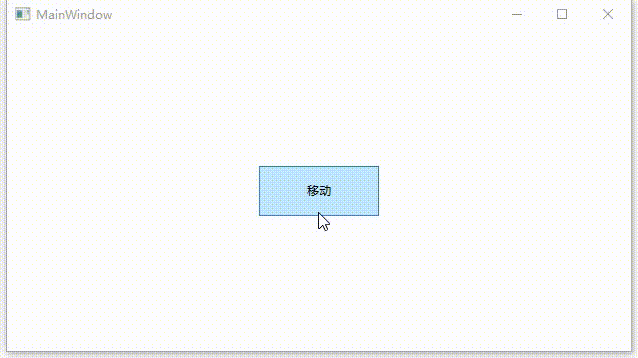这篇文章主要介绍“基于C#的wpf怎么实现Grid内控件拖动”,在日常操作中,相信很多人在基于C#的wpf怎么实现Grid内控件拖动问题上存在疑惑,小编查阅了各式资料,整理出简单好用的操作方法,希望对大家解答”基于C#的wpf怎么实现Grid内控件拖动”的疑惑有所帮助!接下来,请跟着小编一起来学习吧!
前言:
有一些业务场景中我们需要拖动控件,在Grid中就可以实现控件拖动,通过设置Margin属性即可,根据鼠标的移动,设置相应的Margin的Left、Top,当然有时也不是直接设置的,需要根据HorizontalAlignment、VerticalAlignment值有不同的计算方法。
拖动的控件需要注册3个鼠标事件分别是,鼠标按下、鼠标移动、鼠标弹起。
以Button为例:
<Button PreviewMouseDown="Button_MouseDown"
PreviewMouseMove="Button_MouseMove"
PreviewMouseUp="Button_MouseUp"> </Button>在鼠标按下事件中记录位置。
//鼠标是否按下
bool _isMouseDown = false;
//鼠标按下的位置
Point _mouseDownPosition;
//鼠标按下控件的Margin
Thickness _mouseDownMargin;
//鼠标按下事件
private void Button_MouseDown(object sender, MouseButtonEventArgs e)
{
var c = sender as Control;
_isMouseDown = true;
_mouseDownPosition = e.GetPosition(this);
_mouseDownMargin = c.Margin;
}鼠标按下后移动鼠标,控件需要跟随鼠标移动。根据HorizontalAlignment、VerticalAlignment值不同,计算Margin的方式也不同。
private void Button_MouseMove(object sender, MouseEventArgs e)
{
if (_isMouseDown)
{
var c = sender as Control;
var pos = e.GetPosition(this);
var dp = pos - _mouseDownPosition;
double left, top, right, bottom;
if (c.HorizontalAlignment == HorizontalAlignment.Stretch|| c.HorizontalAlignment == HorizontalAlignment.Center)
//中央移动距离是双倍
{
left= _mouseDownMargin.Left+ dp.X * 2;
right = _mouseDownMargin.Right;
}
else if(c.HorizontalAlignment== HorizontalAlignment.Left)
//左边是正常距离
{
left = _mouseDownMargin.Left + dp.X ;
right = _mouseDownMargin.Right;
}
else
//右边是右边距距离
{
left = _mouseDownMargin.Left;
right = _mouseDownMargin.Right - dp.X;
}
if (c.VerticalAlignment == VerticalAlignment.Stretch || c.VerticalAlignment == VerticalAlignment.Center)
//中央移动距离是双倍
{
top = _mouseDownMargin.Top+ dp.Y* 2;
bottom = _mouseDownMargin.Bottom;
}
else if (c.VerticalAlignment == VerticalAlignment.Top)
//顶部是正常距离
{
top = _mouseDownMargin.Top + dp.Y ;
bottom = _mouseDownMargin.Bottom;
}
else
//底部是底边距距离
{
top = _mouseDownMargin.Top ;
bottom = _mouseDownMargin.Bottom- dp.Y;
}
c.Margin = new Thickness(left, top, right, bottom);
}
}鼠标弹起后需要恢复标识,让控件不再跟随鼠标移动。
private void Button_MouseUp(object sender, MouseButtonEventArgs e)
{
if (_isMouseDown)
{
_isMouseDown = false;
//移动了的控件不响应点击事件(此处根据具体需求)
e.Handled = true;
}
}示例代码:
<Window x:Class="WpfControlMove.MainWindow"
xmlns="http://schemas.microsoft.com/winfx/2006/xaml/presentation"
xmlns:x="http://schemas.microsoft.com/winfx/2006/xaml"
xmlns:d="http://schemas.microsoft.com/expression/blend/2008"
xmlns:mc="http://schemas.openxmlformats.org/markup-compatibility/2006"
xmlns:local="clr-namespace:WpfControlMove"
mc:Ignorable="d"
Title="MainWindow" Height="360" Width="640">
<Grid>
<Button Width="120" Height="50" Content="移动" PreviewMouseDown="Button_MouseDown" PreviewMouseMove="Button_MouseMove" PreviewMouseUp="Button_MouseUp"> </Button>
</Grid>
</Window>效果预览:

到此,关于“基于C#的wpf怎么实现Grid内控件拖动”的学习就结束了,希望能够解决大家的疑惑。理论与实践的搭配能更好的帮助大家学习,快去试试吧!若想继续学习更多相关知识,请继续关注亿速云网站,小编会继续努力为大家带来更多实用的文章!
亿速云「云服务器」,即开即用、新一代英特尔至强铂金CPU、三副本存储NVMe SSD云盘,价格低至29元/月。点击查看>>
免责声明:本站发布的内容(图片、视频和文字)以原创、转载和分享为主,文章观点不代表本网站立场,如果涉及侵权请联系站长邮箱:is@yisu.com进行举报,并提供相关证据,一经查实,将立刻删除涉嫌侵权内容。